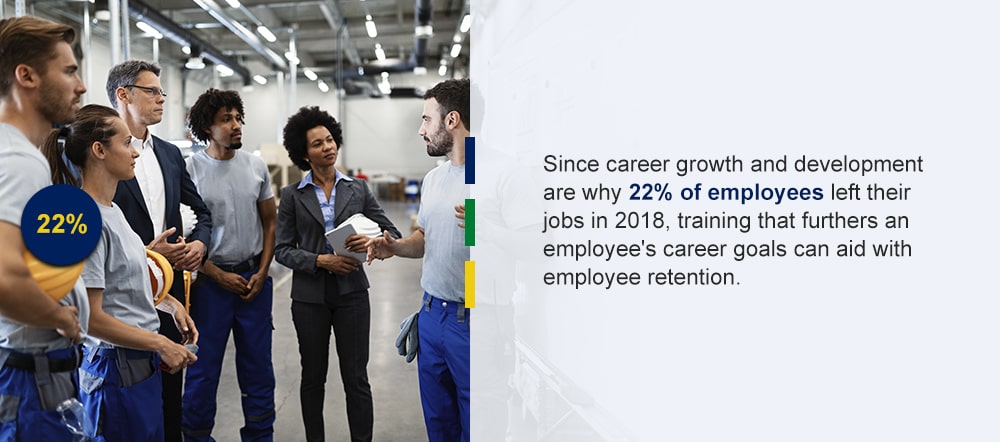In the complex and competitive world of manufacturing, where product quality and operational efficiencies are…
Quick Links
Why Addressing Skills Gaps Is Important
Onboarding in Manufacturing
Training and Apprenticeship
Augmented Reality (AR) in Manufacturing
Learn More About MANTEC Solutions
If you’re like 99% of manufacturers, finding new skilled labor is your first and most urgent challenge. You’ve been having trouble finding talented, qualified workers at the entry-level and above for years. Skills gaps in manufacturing have been a long-time concern for the industry. If we continue on the current path, we’ll be dealing with the fallout from a lack of skills and capable workers for many years. Luckily, the manufacturing industry continues to innovate, creating more attractive job opportunities and adopting new strategies to recruit and retain talent.
Why Addressing Skills Gaps Is Important
In the manufacturing sector, the skills gap is already creating significant issues. The National Association of Manufacturers predicts we will need 4.6 million manufacturing jobs over the next decade. Yet, 2.4 million jobs will go unfilled due to the skills gap. With just over 50% of the industry’s positions going unfilled, manufacturing stands to fall behind in economic growth. The reduced output resulting from the skills gap could cost the manufacturing industry $454 billion in 2028 alone.
Many manufacturers are entering into a difficult situation. Addressing the skills gap without investing in human resources means adopting newer, more efficient technologies. While these technologies provide much-needed support for manufacturing, they also create more high-skilled jobs, which can worsen the skills gap. It’s crucial to invest in your workforce alongside new tools and software.
Closing the skills gap can help your business succeed in many ways. Manufacturers that are strong investors in human capital development are more likely to outrank their competitors in:
- The features and age of their equipment and technology.
- The speed of their executive decision making.
- Their order-to-delivery lead times.
- Their overall cost structure.
- Their new product development cycle times.
The good news for manufacturers is that there are many ways to close the skills gap. By investing in recruitment, retention, training and career development, you can find and retain qualified workers. Waiting for trade schools and the job market to fill in the gaps is not an option. You require critical thinkers and skilled labor now. Some of the solutions you might consider are onboarding, training, apprenticeship and augmented reality.
Onboarding in Manufacturing
As much as 20% of employee turnover occurs in the first 45 days of employment. Meanwhile, the manufacturing sector has a high turnover rate of 26.7%. Experts agree the process of getting an employee up to speed needs to be more thorough and longer than most companies spend. The onboarding process is the first chance to make an impression on new employees, and you need to make it count.
For workers looking to grow in a new role, the initial assimilation process shows them if your company will help them meet their goals. Will you encourage them to learn new skills? Do you take the time to make new team members feel welcome? Are there opportunities for career growth? All these questions can be answered during the onboarding process and through exposure to the company culture. The more support you give, the higher the chances for a long, prudent relationship with a new hire.
In manufacturing, onboarding usually requires extensive initial training. Equipment and procedures are highly technical, even in low-skill jobs. Safety procedures and expectations need to be made clear before recruits can enter the factory floor. Digital onboarding can create a dynamic, safe and feedback-friendly environment for training. Technology can make exercises more engaging and help recruits retain more information.
While the first few months are crucial to the onboarding process, continuous onboarding is becoming prevalent in manufacturing. Manufacturing continuous onboarding is a strategy for longterm workforce engagement and training. It extends onboarding through the span of each employee’s relationship with your company. You end up with better-trained entry-level workers and develop skillful leaders who drive success.
Manufacturers who know how to do continuous onboarding can upskill their own workforce. You can focus more on internal resources than on recruiting top talent. Continuous onboarding is particularly critical when workers change jobs or move into a management role. Training can help first-time managers gain the skills they need to lead.
The program is beneficial because it starts early to improve initial retention and introduce new solutions and skills to employees at every level. With continuous onboarding, even workers who have climbed the ranks and stayed with your company for years will sharpen their skills.

Training and Apprenticeship
Like continuous onboarding, On-The-Job (OTJ) manufacturing training increases career opportunities for low-skill, low-wage workers. It allows workers to continue to learn as they work. With a one-on-one, customized training approach, employees learn more about areas that interest them. Since career growth and development are why 22% of employees left their jobs in 2018, training that furthers an employee’s career goals can aid with employee retention.
Manufacturing apprenticeship programs formalize and improve OTJ training. They can prepare the next generation of employees for leadership roles or specialized jobs. Apprenticeship combines real-world training with technical instruction. It shores up the gaps in many technical school programs by providing hands-on experience so students can gain employment in the field. An apprenticeship program can open the doorway to advancement opportunities within the company. It can help plants close their skills gaps and increase employee retention.
A U.S. Registered Apprenticeship program combines five critical components:
- Business involvement: Commitment from the employer is central to an apprenticeship program. They provide the experience necessary to prepare students to fill the skills gaps in manufacturing.
- Structured OTJ training: The employer offers an experienced mentor for at least one year of training. The apprentice must be a hired, paid employee of the company during this training period.
- Related instruction: An apprentice should also receive technical education in their field. Direction may come from a community college, trade school, apprenticeship training school. It can take place online or even at the job site, provided by the employer.
- Rewards for progression: As apprentices gain new skills, they receive increases in wages to reflect their higher skill level.
- Nationally-recognized credentials: While apprenticeship programs benefit employers by opening pathways within the host company, apprentices need recognition for completed training. They should be able to provide proof of a completed apprenticeship, allowing them to qualify for jobs with any employer. Employers must grant a certificate upon completion of apprenticeship training.
Apprentice programs can be costly since they are employer-funded. They also prepare workers with skills they can take with them to other companies. Many programs can mitigate this by requiring employment for a set length of time at the program’s conclusion. Whether you use this policy or not, many workers choose to stay with their host company after learning the ropes and connecting with the rest of the team.
Augmented Reality (AR) in Manufacturing
Investing in technology is one way many manufacturers are closing the skills gaps. Augmented reality (AR) in manufacturing can contribute to your workforce by boosting productivity and even helping staff upskill with unique training. AR, as opposed to virtual reality, involves placing digital information over real-world images. Workers can use AR through specialized eyeglasses or a screen.
AR can help factory workers locate coworkers and see the parameters machinery is operating under. It can streamline product development by allowing the involved parties to collaborate virtually in real time. AR can also provide virtual mockups to workers in the production line or overlay part names and specs over an image of a completed component. With all parts labeled, workers can quickly verify if they are in the right place, cutting down inspection time.
Predictive maintenance programs can use AR to identify operating conditions and possible failure points in machines. These features speed up time-consuming tasks like digging through equipment maintenance history and meticulously inspecting products. AR actually increases the skills of employees by augmenting their daily responsibilities. With all these low-skill tasks sped up and happening through the aid of technology, workers have more time to focus on high-skill tasks and add to their repertoire of capabilities. AR can help with this process, too.
AR glasses can create virtual clones of physical assets like production equipment. So, through a screen, manufacturing AR provides digital, three-dimensional models workers can practice on. Training programs can use these AR equipment models to show how to apply, service or repair machines on the factory floor. The training program is more dynamic and cost effective than using example machines.
AR can be a beneficial option because it reduces the need for unskilled labor by speeding up these processes. Digital training is more engaging and a fast, inexpensive way to customize training to evolving workforce needs.
Learn More About MANTEC Solutions
Workforce development and careful implementation of new technologies has been helping many manufacturers reduce their skills gaps. MANTEC provides vital services and resources to address the manufacturing skills gap, including workforce engagement and development programs and technological solutions like augmented reality. We can address your skills gap through smarter employee onboarding, ongoing training and leadership development.
As a nonprofit firm founded by and for manufacturing professionals, we provide expert advice and services geared toward our industry. We also offer solutions at an affordable rate because we understand how investing in Pennsylvania manufacturing will boost our local economy and help you stay competitive in our area and the global economy.




